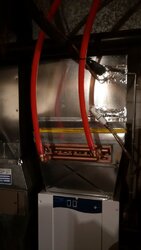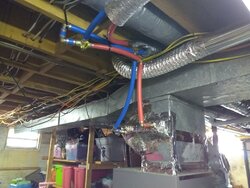Hey Folks,
First Summer here with the new boiler (HeatMaster G200). Setup inside is a forced air electric furnace (backup) with central A/C and duct work throughout house, water heater is electric. We might burn this summer for our DHW, we also might not, I haven't decided...few questions on the 2 scenarios below. I attached a pic of setup at the furnace too...A/C coil is at top where black/copper piping enters furnace, the hydronic water-air heat exchanger is at the bottom there where red pex is.

Scenario 1 - we completely shut down the boiler and not burn wood this summer. Use electric water heater for DHW, and our central A/C for cooling. Is there a risk of the water-air heat exchanger that sits in the furnace freezing up and bursting from the A/C use? (I was told originally to just leave the water in the boiler/loop in summer, so don't drain it, but shut all boiler power off, circ. pumps, etc - is this correct? - that means water will be sitting still in the water-air heat exchanger in furnace - will this freeze/burst from A/C?)
Scenario 2 - we do burn wood this summer in boiler for our DHW (electric water heater off). In this scenario, wouldn't the A/C have to work harder because there will be hot water from boiler going through water-air heat exchanger in furnace, so the fan would be blowing that hot air over A/C coil and mixing it with cold air from A/C, meaning the air coming out of vents isn't as cold as A/C working with boiler loop shut down like in scenario 1? If I am thinking of this correctly, how do you get around this - would you need by-pass valves/piping at the water-air heat exchanger in furnace so the hot water in boiler loop doesn't go through that exchanger, and it just skips it and continues along the loop back to the boiler - this way no heat from boiler water enters the furnace during A/C use and A/C would just function as normal and we can still burn wood for the DHW only?
Thanks.
First Summer here with the new boiler (HeatMaster G200). Setup inside is a forced air electric furnace (backup) with central A/C and duct work throughout house, water heater is electric. We might burn this summer for our DHW, we also might not, I haven't decided...few questions on the 2 scenarios below. I attached a pic of setup at the furnace too...A/C coil is at top where black/copper piping enters furnace, the hydronic water-air heat exchanger is at the bottom there where red pex is.

Scenario 1 - we completely shut down the boiler and not burn wood this summer. Use electric water heater for DHW, and our central A/C for cooling. Is there a risk of the water-air heat exchanger that sits in the furnace freezing up and bursting from the A/C use? (I was told originally to just leave the water in the boiler/loop in summer, so don't drain it, but shut all boiler power off, circ. pumps, etc - is this correct? - that means water will be sitting still in the water-air heat exchanger in furnace - will this freeze/burst from A/C?)
Scenario 2 - we do burn wood this summer in boiler for our DHW (electric water heater off). In this scenario, wouldn't the A/C have to work harder because there will be hot water from boiler going through water-air heat exchanger in furnace, so the fan would be blowing that hot air over A/C coil and mixing it with cold air from A/C, meaning the air coming out of vents isn't as cold as A/C working with boiler loop shut down like in scenario 1? If I am thinking of this correctly, how do you get around this - would you need by-pass valves/piping at the water-air heat exchanger in furnace so the hot water in boiler loop doesn't go through that exchanger, and it just skips it and continues along the loop back to the boiler - this way no heat from boiler water enters the furnace during A/C use and A/C would just function as normal and we can still burn wood for the DHW only?
Thanks.


